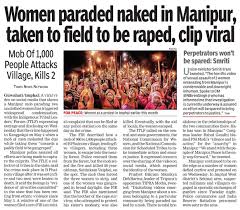The violence in Manipur, which began in May 2023, has been marked by ethnic clashes primarily between the Meitei community, who are predominantly Hindu and live in the Imphal Valley, and the Kuki-Zo tribes, mostly Christian and settled in the hills surrounding the valley. The conflict has led to widespread unrest, violent confrontations, and significant casualties. Here’s an overview of the situation:






Context of the Conflict
Ethnic and Political Tensions: The roots of the violence lie in longstanding ethnic and political tensions between the Meitei community (which makes up about 53% of the population but is concentrated in the Imphal Valley) and the Kuki-Zo tribal groups (who make up around 40% and primarily inhabit the hill districts). The Meiteis are demanding Scheduled Tribe (ST) status, which would provide them with affirmative action benefits such as quotas in government jobs and educational institutions. However, the Kuki-Zo communities oppose this demand, fearing it could affect their own reservation benefits and land rights.
Land and Resource Distribution: Manipur has been dealing with issues of land ownership and resource distribution for years. The Meitei community, largely urban and concentrated in the valley, has clashed with the hill-dwelling Kuki and Naga tribes, who feel marginalized by the state’s political and economic policies.
Trigger of the Violence
The violence erupted after the state government, led by the Bharatiya Janata Party (BJP), recommended granting the Meitei community ST status. This sparked fears among the Kuki and Naga tribes that it would lead to an influx of Meitei people into their territories, resulting in competition for resources and loss of their own political and economic advantages.
The violence intensified when mobs clashed in different parts of the state, with houses, villages, and churches burned, and large-scale displacement of people occurred. Both sides accused each other of targeting civilians and instigating violence.
The Role of Security Forces
The Indian Army and Assam Rifles were deployed in the region to restore order, but the situation has remained volatile with continued outbreaks of violence. The state’s law enforcement and security agencies have been criticized for their inability to control the situation and prevent communal violence from spiraling out of control.
The internet was suspended in several areas to prevent the spread of inflammatory content, and curfews were imposed. Despite these measures, the violence escalated, leading to significant casualties on both sides. The exact number of deaths remains uncertain, but hundreds of people have been killed, and thousands have been displaced.
Humanitarian Crisis
The violence has resulted in a serious humanitarian crisis, with thousands of people being displaced from their homes. The displaced persons have sought refuge in makeshift camps set up by the government and NGOs, but these camps are often overcrowded and lack adequate facilities. The violence has also severely disrupted daily life, including education, healthcare, and the economy.
In addition to the physical violence, there have been reports of sexual violence, targeted attacks on minority groups, and other human rights abuses. The situation has raised concerns over ethnic cleansing in certain areas.
Political Responses
The conflict has put immense pressure on the state and central governments. The state government, led by the BJP, has been accused by opposition parties and civil rights organizations of failing to act swiftly and decisively to prevent the violence. Critics argue that the BJP’s support for Meitei demands for ST status has exacerbated the situation.
The central government has been criticized for its delayed response and failure to address the grievances of both the Meitei and Kuki-Zo communities. In response, the government has called for peace talks and the establishment of peace-building initiatives, but there has been little progress on the ground.
Impact on the Broader Region:
The conflict has had ripple effects beyond Manipur. Neighboring states like Nagaland and Mizoram have expressed concern over the situation, especially since many Kuki-Zo refugees have sought shelter in these states. The violence has also highlighted the deep ethnic fault lines in India’s northeastern states, where multiple communities and insurgent groups have been engaged in political struggles for decades.
International Attention
While the conflict has drawn significant national attention, international coverage has been relatively limited. Human rights organizations like Human Rights Watch and Amnesty International have raised concerns about the situation and the government’s handling of the crisis. They have called for an independent investigation into the human rights violations and for greater protection of displaced persons.
Current Situation
the situation in Manipur remains fragile. While there have been attempts at dialogue and peace-building, trust between the Meitei and Kuki-Zo communities remains low. The displacement of thousands continues to put pressure on the state and central governments to find a sustainable solution.
The violence in Manipur is a complex and deeply rooted conflict driven by ethnic, political, and economic factors. While the state and central governments have made attempts to mediate and restore peace, the lack of a long-term resolution to the grievances of both the Meitei and Kuki-Zo communities continues to fuel instability in the region.












